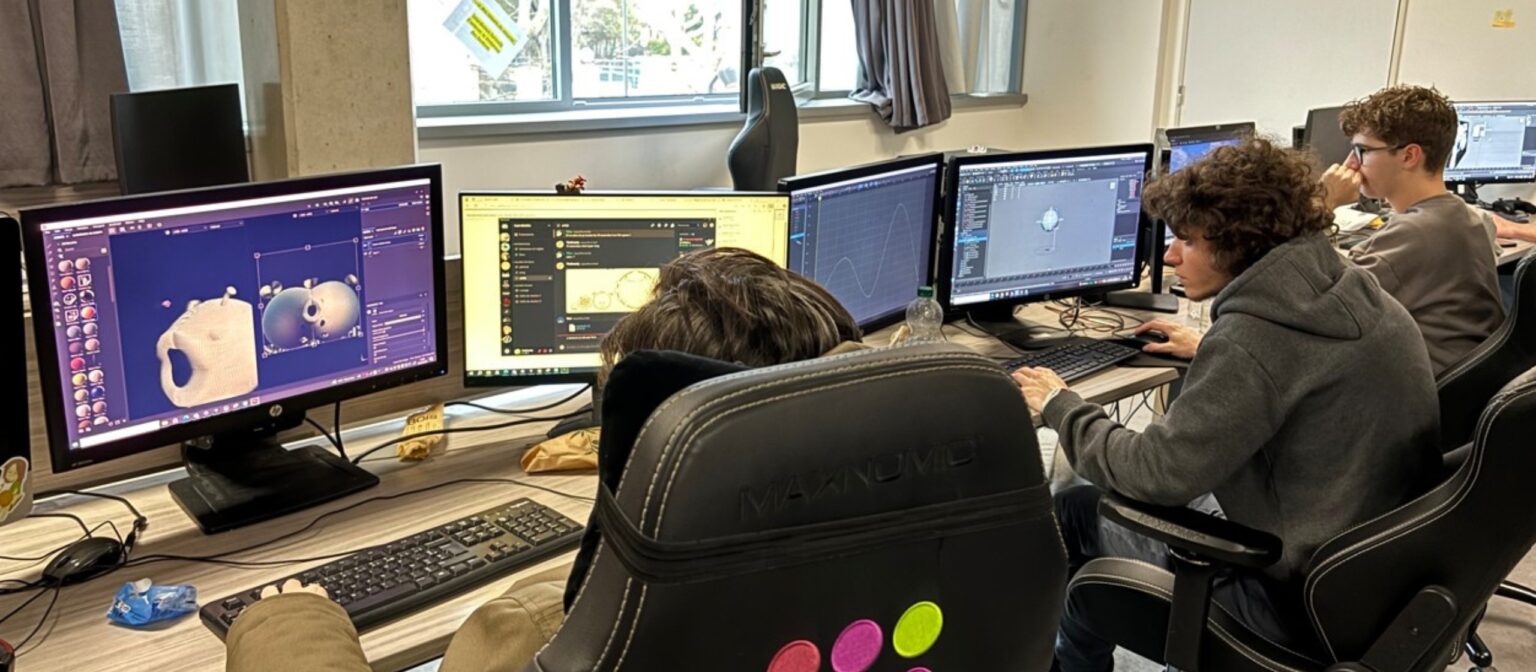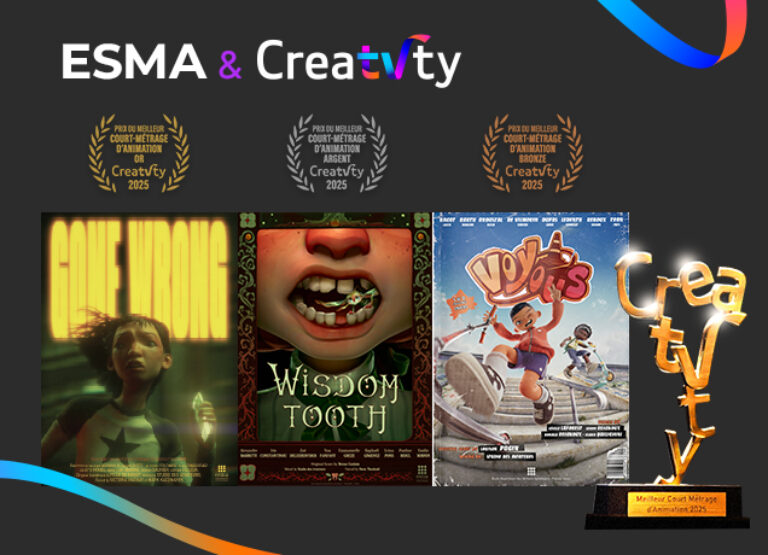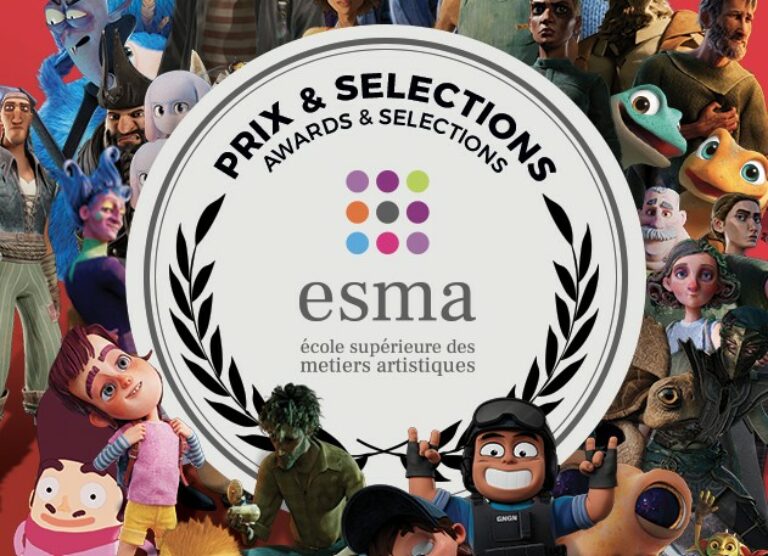
- Published 02.18.2025
- type Thematic news items
- Training Video Game
If you’re searching for a job in video game animation, this guide gives you exactly what you need. You’ll learn about the most in-demand animation jobs, what each one involves, the tools you’ll use, and how to choose the path that fits you best.
The video game industry is constantly evolving and offers a variety of exciting professions, particularly in the field of animation.
The characters, creatures and animals we see on the screen come to life thanks to the hard work of a team of specialised artists. The use of techniques such as motion capture (MOCAP) has opened up new possibilities and created specific professions.
Here are some of the jobs in video game animation:
Types of Video Game Animation Jobs
1.Character Designer
This is the artist who creates the characters, creatures and animals for a video game. He designs their physical appearance, their clothes, their expressions and their movements.
- Designs characters, creatures, and animals for video games
- Focuses on appearance, clothes, expressions, and poses
- Requires strong drawing skills and experience in 2D/3D software
- Knowing game culture and trends helps
2. 3D animator
The 3D animator is the master of movement. He breathes life into characters and objects by creating fluid and expressive animations. His work is crucial in giving a realistic and immersive dimension to the gaming experience. He uses specialised software to model the movements, facial expressions and interactions of the characters with their environment. The 3D animator can work with motion capture data (MOCAP) for an even more realistic rendering.
- Creates movement and brings characters to life
- Works on realistic facial expressions and motion
- Often uses motion capture (MOCAP) data
- Tools: Maya, Blender, MotionBuilder
3. 3D Modeller
The 3D modeller is the architect of the virtual world. They create the shapes and textures of the characters, objects and environments in the game.
- Builds characters, objects, and environments in 3D
- Uses modeling software to turn designs into game-ready assets
- Common tools: Maya, Blender, ZBrush
4. The rigger
The rigger is a virtual anatomy specialist. They create the skeleton and joints of 3D characters, allowing animators to manipulate them and bring them to life. Their work is essential to ensure the fluidity and realism of the characters’ movements. The rigger can also adapt the virtual skeleton to motion capture data (MOCAP).
- Creates the skeletons that animators use
- Makes sure movements look smooth and believable
- Sets up rigs for facial expressions, limbs, and body motion
- Works closely with animators and uses MOCAP-ready setups
5. VFX Artist
The VFX graphic designer is the magician of the video game. He creates the visual effects that add spectacle and immersion to the gaming experience
- Designs visual effects like explosions, fire, smoke, and magic
- Adds energy and drama to the game world
- Tools: Houdini, Niagara, Unity/Unreal visual effects editors
6. Texture Artist (Surface graphic designer)
The surface graphic designer is the master of textures and materials. He gives characters, objects and environments their visual appearance. He defines the colours, patterns and surface effects to create a realistic and credible rendering.
- Creates materials and surface details for objects and characters
- Designs how skin, metal, fabric, or stone should look
- Uses Photoshop and 3D painting tools
7. Lighting Artist
The lighting Arstist is the master of light. He illuminates the game scenes to create the desired visual ambience. He uses light to emphasise important elements, create contrasts and give the story a dramatic dimension.
- Sets the visual mood using light
- Highlights key parts of scenes and supports the story visually
- Balances brightness, contrast, and shadow
- Tools include Unity, Unreal Engine, and real-time renderers
8. Artistic director
The artistic director is responsible for the visual consistency of the game. He supervises all the graphic aspects of the project and collaborates with the various artists.
- Leads the visual style and tone of the game
- Guides the team to keep a consistent look across assets
- Works closely with all artists to align visuals with game vision
9. Game designer
The game designer is the brain of the game. They design the rules, game mechanics and levels to provide an engaging and entertaining experience for players. They come up with the challenges, puzzles and rewards that will punctuate the virtual adventure.
- Designs how the game works: rules, levels, goals, and rewards
- Balances gameplay to make it fun and challenging
- Works with artists and programmers to bring ideas to life
10. Programmer
The programmer is the video game engineer. He translates the designers’ ideas into virtual reality by developing the code that brings the game to life. He is responsible for integrating the animations, special effects and interactions with the environment.
- Builds the code that powers the game
- Integrates art, animations, audio, and user interactions
- Makes the game playable and responsive
How to choose your role
Think about what you enjoy most:
- Do you love to draw? Explore roles like character designer or texture artist.
- Do you enjoy coding and logic? Look into becoming a programmer or rigger.
- Are you into motion and visuals? Animation and VFX might be a great fit.
To find your path:
- Try different creative tools.
- Build mini projects.
- Join game jams.
- Study at a creative school like ESMA to develop your strengths.
Careers related to MOCAP
MOCAP specialist: The MOCAP specialist is responsible for capturing the movements of a real actor using sensors and cameras. He configures the equipment, directs the actor and cleans up the recorded data.
MOCAP technician: The MOCAP technician is responsible for the maintenance and proper functioning of the motion capture equipment. He installs the sensors, calibrates the cameras and ensures the quality of the recorded data.
MOCAP data cleaner: The MOCAP data cleaner is responsible for cleaning and processing motion capture data. He corrects errors, optimises movements and adapts them to the virtual skeleton of the characters.
Skills required
The skills required to work in video game animation vary depending on the position, but certain qualities are essential:
- Creativity: The video game industry is fertile ground for the imagination. Whatever the job, a dose of creativity is essential to design original and captivating animations, characters and worlds.
- Technical skills: Proficiency in software is essential. Each profession has its preferred tools, whether 3D animation software such as Maya or 3ds Max, modelling software such as Blender, or development tools for programmers.
- Teamwork: Creating a video game is a collective effort that involves the collaboration of many talents. Knowing how to work in a team, communicate effectively and listen to others is crucial to the success of a project. Knowing and understanding the different professions and their constraints is also crucial in the project process.
- Artistic sense: Animation is the art of movement. Good timing, an understanding of rhythm and aesthetic sensitivity are important for creating fluid, expressive and coherent animations.
- Passion for video games: To thrive in the world of video games, it is essential to be passionate about them. Knowledge of the different genres of games, market trends and player expectations is a valuable asset. That is why it is essential to keep a regular eye on the latest innovations and trends in the video game sector.
Career opportunities
The video game industry is growing and offers great career opportunities:
- High employability: The video game market is constantly expanding, and the demand for 3D animators, modelers, character designers and other specialists is growing steadily. The sector is actively recruiting talent to meet the needs of development studios and game publishers. Although the sector has experienced a crisis in recent months, the long-term trend remains that of a growing sector, and a recovery can therefore be anticipated in the coming months and years.
- Diversity of positions: Video game animation jobs open the door to a wide variety of work environments. Professionals can work in video game studios, advertising agencies, companies specialising in the creation of multimedia content, or even choose to work freelance. Not forgetting the various specialised industries. This can include, for example, animation in the context of Occupational Health and Safety, Research and Development, design and construction such as machines, vehicles, exoskeletons, etc.
- Professional development: The video game industry offers interesting prospects for development. Animators and other artists can progress to positions of responsibility such as lead animator, lead graphic designer, animation supervisor, creative director, artistic director or project manager. The experience, portfolio and skills acquired through the projects pave the way for rewarding careers.
- Possibilities for reorientation: It is also important to keep in mind the possible exit doors from a sector, for example if one wishes, in the middle of one’s career, to change creative challenges. And indeed, recent years have proven that video games allow one to move into other fields: VR experiences, advertising, work on animation series created under Unreal Engine are good examples.
- Remuneration: Salaries in video game animation are generally competitive, varying according to the level of experience and the position held.
- At the beginning of their career, a character designer can earn between €20,000 and €30,000 per year.
- Abroad, salaries can double, reaching nearly $63,000 per year.
ESMA Alumni in the Industry
Graduates from ESMA work in top studios across the globe. They create art, design gameplay, and build the tools behind hit games. You can see their work and paths here: ESMA Alumni





